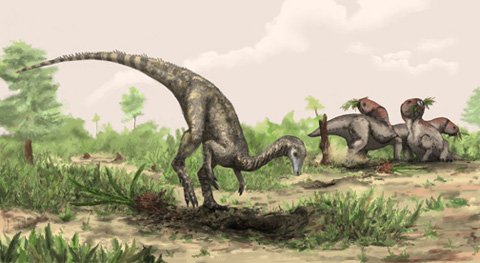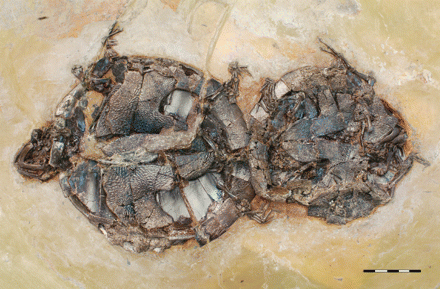How species are like pornography: Species concepts and the fossil record
Recently I helped name a new species, an animal we think is the oldest dinosaur found to date—if not, it’s the closest cousin to dinosaurs we know of (Nesbitt et al. 2013). It was the first time I’ve named a new species of anything, though given my profession, it’s likely I’ll get to name others in the future. Our new species (Nyasasaurus parringtoni) was described based on two partial specimens, which together comprise just twelve bones: a humerus (upper arm bone) and a bunch of vertebrae (back bones). You can see and download photos of all the bones of Nyasasaurus here, for free. Now, we don’t have a lot of bones to go on, and we don’t think Nyasasaurus was a one-armed, ridiculously short-backed dinosaur with no head. And two of my co-authors have shown there are other, closely-related animals found in the same rock formation (Nesbitt et al. 2010). So how did we know we were looking at a new species?

Image (c) 2012 Natural History Museum, London and Mark Witton, and available here.
For that matter, how does any paleontologist know they are looking at a new species? And what do we mean by the word “species”, anyway? Unfortunately, my answer to that is: it depends on who you talk to.
One common definition of “species” goes something like this: “a group of organisms that can interbreed in nature and produce fertile offspring, but that can’t mate with other groups and produce fertile offspring”. This way of defining species is called the biological species concept, and it centers around the observation that species tend to be isolated from other species, reproductively-speaking, even when they live in the same area.
Applying the biological species concept to fossil animals is problematic because it’s difficult to prove whether or not they were reproductively isolated from each other. Finding fossil vertebrates that died in the act of mating is pretty rare (though check out these lascivious turtles), but even when you find them, that tells you more about mate choice than mating isolation. In the fossil record, the best evidence for reproductive isolation is when organisms are separated by many millions of years, but even that doesn’t rule out a really long-lived species.
So, vertebrate paleontologists tend to think about fossil species using definitions other than the biological species concept (which, if you think about it, is also not so helpful for organisms that don’t have sex, or ones that hybridize easily, like plants). One common definition we use is called the morphological species concept, which more or less means “a group of organisms that shares anatomical characteristics within the group, which are not shared with other groups of organisms”. Basically, organisms that look similar to each other and different from everything else.

Image (c) 2007 José Nestor Cardoso, and available here on a CC BY-SA 3.0
Another common way we think about fossil species is the phylogenetic species concept, which requires an analysis of evolutionary relationships. Under this definition, species are the smallest groups of organisms that both share a common ancestor and are evolutionarily distinct from all the other groups on the tree. Anatomical characteristics are the data we use to reconstruct evolutionary relationships for fossil species, so in reality, most fossil vertebrate species are described using a hybrid method that takes into account both anatomy and evolutionary relationships. In the Nyasasaurus example above, the combination of anatomical features we see in those twelve bones are unique, and they fall out in a novel position on the dinosaur family tree.
It may be surprising that different scientists define species in different ways. A lot of this depends on what type of organism that person does their research on, because many definitions work really well for a particular group of organisms, but are completely inapplicable to other groups of organisms. If you’re a paleontologist, you won’t have much use for a definition that requires showing genetic isolation or genetic similarity, because it will be difficult to apply to most fossil organisms. Similarly, a bacteriologist might not find the morphological species concept too helpful when trying to sort out thousands of species that look identical under the microscope.
Interestingly, the idea that experts should determine which characteristics and species definition are most biologically relevant to the organisms they work on and define species that way is its own species concept: the taxonomic species concept. Though I feel that this is probably the most practical species concept (it’s basically what goes on now), it does have that unsatisfying “I know it when I see it” quality. Who would have guessed that species and pornography could be identified using the same, Supreme Court-sanctioned method?

Image from Joyce et al. (2012), available here.
The difficulty of finding and agreeing on a universal definition for “species” has led some biologists to doubt whether species are biologically real entities at all (Mishler 2010). Rather, they argue that species are arbitrary constructs that biologists impose on the natural world. I think that this viewpoint is a bit extreme; when organisms pass on their DNA in fundamentally different ways (sex vs. no sex, for example), why should we expect a one-size-fits-all definition of species to work?
However, if you use the taxonomic species concept, you have to acknowledge that all species are not exactly biologically equivalent to each other, because we use different methods to parse out what a species in each group. And our opinion of what a species is might be very different from the organisms’ opinion. With genetic data cheaper than ever to obtain, we’re just starting to discover how many species we’ve been lumping together because they look so similar. Despite anatomical similarity, these species have clearly been genetically isolated for many years. We call these groups “cryptic species”, and some types of organisms are much more likely to have cryptic species than other (see Bickford et al. 2007 for a review).
We already know that the fossil record is incomplete; even as good as it is, not every species will be preserved. Right off the bat, any estimate of past species diversity based on fossils is an underestimate. But even among the species we know about and have described, we’re going to miss all the cryptic species. Genetic studies of fossils are still technologically impossible for taxa that have been extinct for hundreds of millions of years, and the skeleton (or a small part of it, in the case of Nyasasaurus) is often all we have to go on. So what we call a fossil “species” might actually have involved several genetically distinct, reproductively isolated groups back in the day.
Now that we’re on the same page regarding how paleontologists think about fossil species, I’ll cover more of the nuts and bolts of how we figure out something is new to science next time. For more on species concepts, go here for the basics, here for a longer list, and here for a very thorough explanation.
References
Bickford D, et al. 2007. Cryptic species as a window on diversity and conservation. TRENDS in Ecology and Evolution 22: 148-155.
Joyce WG, et al. 2012. Caught in the act: the first record of copulating fossil vertebrates. Biology Letters 8: 846-848.
Mishler BD. 2010. Species are not uniquely real biological entities. pp 110-122 in: Ayala FJ and R Arp, Eds. Contemporary Debates in Philosophy of Biology. Wiley-Blackwell, Singapore. 440pp.
Nesbitt SJ, et al. 2010. Ecologically distinct dinosaurian sister group shows early diversification of Ornithodira. Nature 464: 95-98.
Nesbitt SJ, et al. 2013. The oldest dinosaur? A Middle Triassic dinosauriform from Tanzania. Biology Letters 9: 3pp.
